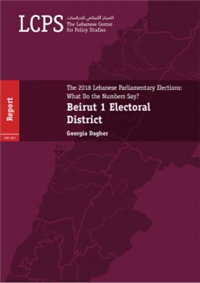Beirut 1: What’s in the Ballot Box? Unpacking the 2018 Elections

Lebanese citizens were finally given the opportunity to renew their political representation in 2018—nine years after the previous parliamentary elections. Despite this, voters in Beirut 1 were weakly mobilized, and the district had the lowest turnout rate across the country. Some voters were more mobilized than others: Greek Orthodox, Maronite, and Sunni voters were the most likely to vote, while Christian minorities, Armenian Orthodox, and Armenian Catholics were the least likely to do so. The race in Beirut 1 was highly competitive: While the Armenian Orthodox and Armenian Catholic vote overwhelmingly went to Tashnag—the main Armenian party—the Maronite, Greek Orthodox, and Greek Catholic votes were highly contested between the three main Christian parties—the Free Patriotic Movement, Lebanese Forces, and Kataeb. Beirut 1 was also the district in which the percentage of votes cast for co-sectarian candidates was lowest, although there were variations. Armenian Orthodox voters were the most likely, and Christian minorities the least likely to vote for a co-sectarian candidate. Rather than voting for candidates of the same sectarian group, Armenian voters in Beirut 1 voted for Armenian candidates, while Greek Orthodox, Maronite, and Greek Catholic voters voted for candidates from each of the three sectarian groups. Although the sectarian bias was low, even Kulluna Watani candidates tended to perform better among their sectarian community. Some diverging voting patterns across genders were also observed: Compared to men voters, women voted much more for women candidates and for the Kulluna Watani list, as well as for each of its candidates. Apart from voters’ preferences, there were some minor signs of irregularities on the part of the three main Christian parties. The Free Patriotic Movement and Lebanese Forces received significantly better results in polling stations that recorded very high turnouts, which could suggest voter rigging. In addition, the distribution of votes for these two parties and Kataeb was not uniform, which could suggest vote-rigging.
Georgia Dagher
former researcher at the Lebanese Center for Policy Studies (LCPS)
 Lebanese citizens were finally given the opportunity to renew their political representation in 2018—nine years after the previous parliamentary elections. Despite this, voters in Beirut 1 were weakly mobilized, and the district had the lowest turnout rate across the country. Some voters were more mobilized than others: Greek Orthodox, Maronite, and Sunni voters were the most likely to vote, while Christian minorities, Armenian Orthodox, and Armenian Catholics were the least likely to do so. The race in Beirut 1 was highly competitive: While the Armenian Orthodox and Armenian Catholic vote overwhelmingly went to Tashnag—the main Armenian party—the Maronite, Greek Orthodox, and Greek Catholic votes were highly contested between the three main Christian parties—the Free Patriotic Movement, Lebanese Forces, and Kataeb. Beirut 1 was also the district in which the percentage of votes cast for co-sectarian candidates was lowest, although there were variations. Armenian Orthodox voters were the most likely, and Christian minorities the least likely to vote for a co-sectarian candidate. Rather than voting for candidates of the same sectarian group, Armenian voters in Beirut 1 voted for Armenian candidates, while Greek Orthodox, Maronite, and Greek Catholic voters voted for candidates from each of the three sectarian groups. Although the sectarian bias was low, even Kulluna Watani candidates tended to perform better among their sectarian community. Some diverging voting patterns across genders were also observed: Compared to men voters, women voted much more for women candidates and for the Kulluna Watani list, as well as for each of its candidates. Apart from voters’ preferences, there were some minor signs of irregularities on the part of the three main Christian parties. The Free Patriotic Movement and Lebanese Forces received significantly better results in polling stations that recorded very high turnouts, which could suggest voter rigging. In addition, the distribution of votes for these two parties and Kataeb was not uniform, which could suggest vote-rigging.Georgia Dagher former researcher at the Lebanese Center for Policy Studies (LCPS)
Lebanese citizens were finally given the opportunity to renew their political representation in 2018—nine years after the previous parliamentary elections. Despite this, voters in Beirut 1 were weakly mobilized, and the district had the lowest turnout rate across the country. Some voters were more mobilized than others: Greek Orthodox, Maronite, and Sunni voters were the most likely to vote, while Christian minorities, Armenian Orthodox, and Armenian Catholics were the least likely to do so. The race in Beirut 1 was highly competitive: While the Armenian Orthodox and Armenian Catholic vote overwhelmingly went to Tashnag—the main Armenian party—the Maronite, Greek Orthodox, and Greek Catholic votes were highly contested between the three main Christian parties—the Free Patriotic Movement, Lebanese Forces, and Kataeb. Beirut 1 was also the district in which the percentage of votes cast for co-sectarian candidates was lowest, although there were variations. Armenian Orthodox voters were the most likely, and Christian minorities the least likely to vote for a co-sectarian candidate. Rather than voting for candidates of the same sectarian group, Armenian voters in Beirut 1 voted for Armenian candidates, while Greek Orthodox, Maronite, and Greek Catholic voters voted for candidates from each of the three sectarian groups. Although the sectarian bias was low, even Kulluna Watani candidates tended to perform better among their sectarian community. Some diverging voting patterns across genders were also observed: Compared to men voters, women voted much more for women candidates and for the Kulluna Watani list, as well as for each of its candidates. Apart from voters’ preferences, there were some minor signs of irregularities on the part of the three main Christian parties. The Free Patriotic Movement and Lebanese Forces received significantly better results in polling stations that recorded very high turnouts, which could suggest voter rigging. In addition, the distribution of votes for these two parties and Kataeb was not uniform, which could suggest vote-rigging.Georgia Dagher former researcher at the Lebanese Center for Policy Studies (LCPS)